As well as holding cupboard and cabinet doors closed, Magnetic catches are an ideal method of providing hidden access points by making a kitchen filler panel into a door without hinges.
Using magnetic catches, a filler panel can be held (the black section in the image below) in place to give the illusion of a fixed panel, when in fact, it could just be hiding access to stop cocks, appliance wastes, electrical fittings etc…. or they can be simply used to keep a door, or cupboard open or closed.
The principle is simple. One side of the catch is a magnet, or series of magnets and the other side is a small section of steel plate which is screwed to the unit. The magnetic catches are screwed to the other section of the unit and where the two meet – they stay!

Magnetic catches hold a kitchen cabinet filler panel in place
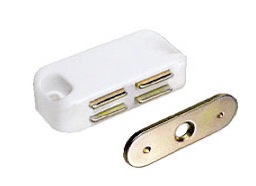
Magnetic catches and a cheap way of keeping cupboard doors closed – Available from Amazon here
In the images below we have closed the gap between two kitchen units to hide the mains water stop cock and the associated pipe work.
Using magnetic catches gives easy access to the pipe work without the hassle of fitting hinges to the door. The panel is simply pulled from the bottom and it comes off in one piece allowing full access to the work behind without being encumbered by a door which cannot be fully opened.
The black section between the two cupboard doors is the cover hiding this gap. As you can see it is a tidy job and looks entirely permanent but the cover timber or plate is easily pulled off to allow access to the stop cock behind.
The magnet part of the catch is fixed onto some battens which in turn are fixed to the unit and the steel plates are fixed to the cover timber.
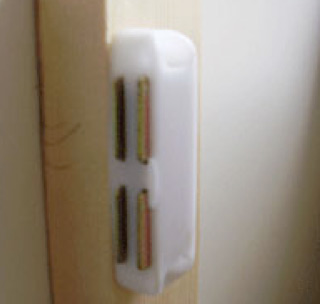
Four individual magnets give the catch strength
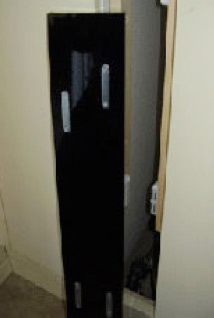
Magnetic cathes remove the need for cabinet hinges
The more magnetic catches you use on a cupboard or cabinet door, the stronger the hold will be. Conversely, for a really light touch where the attraction between, for example, a cupboard door and the frame it closes into, is very gentle, the magnet can be positioned a little further back on the frame so it does not quite touch the steel plate.
The magnetism between the two will still work but the magnet will only exert a small attraction making it easy to open the door.
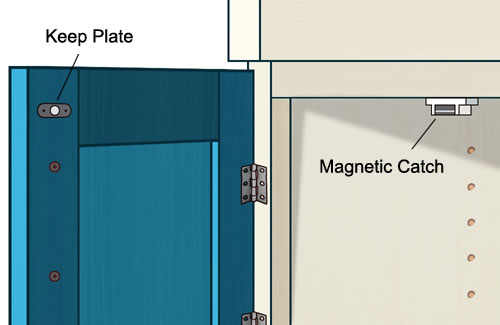
Magnetic catch and door keep fitted to kitchen cupbaord door
Soft Closing Hinges
While magnetic catches are great for holding doors closed, the kitchen cupboard door hinge makes them largely unnecessary as the hinge not only closes the door, but keeps it closed with the spring pressure created against the cupboard door frame.
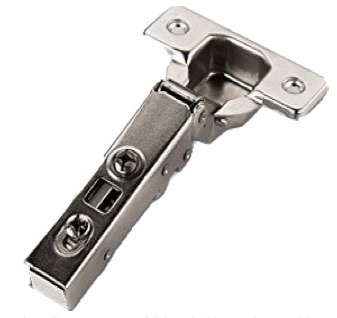
Soft closing hinges for use on kitchen cabinets and cupboards – Available from Amazon here
Soft closing kitchen cupboard and cabinet hinges are like a soft closing toilet seat; they allow the door to close gently against the cupboard with no banging and no stress on the hinge as (usually) it bangs loudly against the cupboard. It also protects little fingers as they close gently!
They are no more difficult to fit that normal cupboard hinges and while ever so slightly more expensive, usually last longer. They are fitted with the same type of hinge boring drill bit that normal cupboard hinges are fitted with.
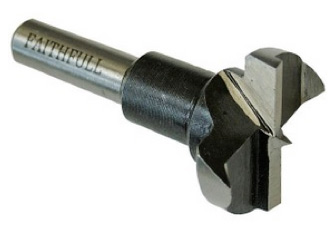
Fitting kitchen cupboard hinges with a hinge boring drill bit
If you are going down the soft close route for your kitchen cupboard doors, you might also want to look at soft closing kitchen drawer runners also. These take all the stress away from the front of the kitchen drawer as it is closed and, without doubt, the front of the drawer is the first thing to come loose in any kitchen!
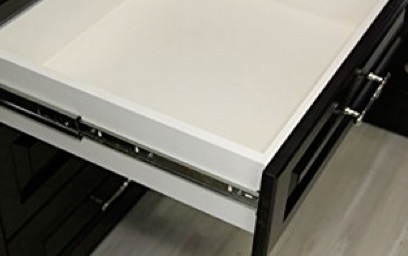
Remove stress from drawer fronts with soft close runners
Kitchen Cupboard Door Damper Buffers
If you would rather leave your kitchen cupboard hinges as they are but would still prefer them to close more gently, you can fit some kitchen door damper buffers to the inside of the cupboard.
The downside to these damper buffers is that they do take up a tiny bit of cupboard space but the results are the same as the soft close door hinges in that the door closes gently, putting less strain on the door and it’s hinges while protecting children’s fingers from a slamming cupboard door.
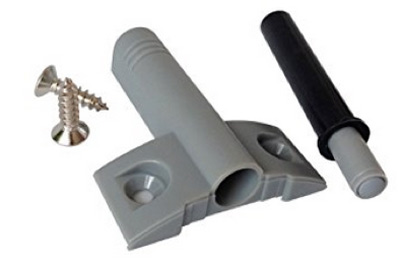
Protect cupboard doors and fingers with cupboard door damper buffers – Available here on Amazon
The damper bracket is fitted to the inside wall of the cupboard and sited close to the hinge. There is a tendency amongst kitchen fitters to put dampers at the top of the cupboard but this is wrong. They should always be fitted near the hinge so any pressure against the door is at the hinge. You can see this from the image.
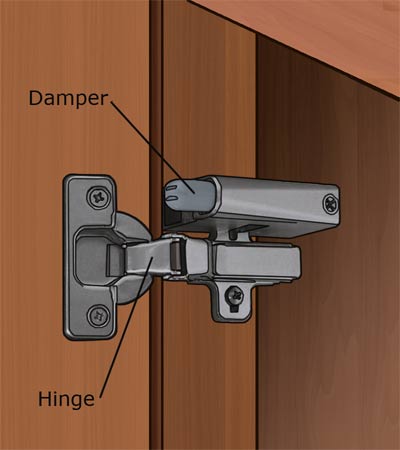
Cupboard door damper fixed next to hinge to allow door to close smoothly and slowly
Roller Catches
Roller catches come in a variety of shapes and sizes but essentially the principle is the same. A keep plate or fitting holds, or is held, by a roller, or multiple rollers, allowing opening and closing of the cupboard or unit catch to be a smooth operation without the need for opening and closing a handle.
Some roller catches are mortised into the door by simply drilling a (usually 16mm) hole in the leading edge of the door. The keep is then inserted into the frame and the roller adjusted from the front with a screwdriver so it fits snugly into the keep.
Roller catches are usually sold in either Brass or Chrome colours
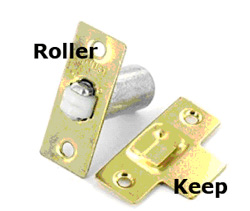
Mortise roller catches remove the need for moving latches or handles to operate – Available on Amazon here
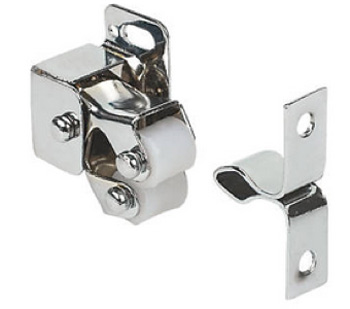
Usually for cupboards this roller catch is easily fitted – Available from Screwfix here
Push to Open Magnetic Cupboard Door Latches
Push to open latches are a very clever idea that, if required, can do away with cupboard door knobs and handles all together. The catch is fitted to the side of the cupboard with a small steel plate (exactly like a magnetic catch, above) fitted to the door.
The catch has a retaining clip in its body so when the door is pushed against it, the magnet holds the door in place. When the door is pushed back fully, the retaining clip within the catch clicks into place and the door is held shut.
In reality, this is really no cleverer than a magnetic catch which also holds the door shout – However…..If you push a tiny bit on the door, the retaining clip is released and the door springs open. Genius!
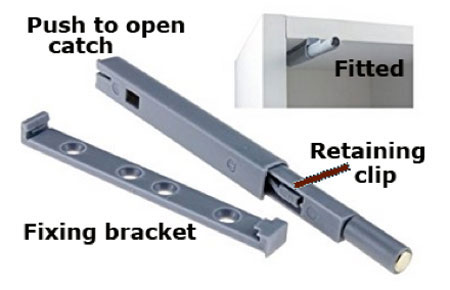
Push to open catches require door to be hung well – Available from Amazon
There are a few types of push to open catches and some are non magnetic. These require the door to be hung well enough that it will stay shut, perfectly in line with the frame, without the use of the added “pull” a magnet offers.
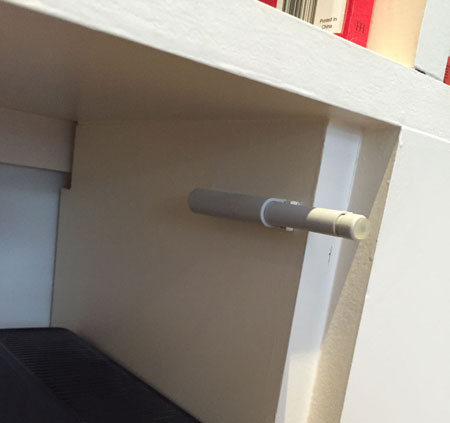
Push to open catch fitted to a bespoke cupboard and shelving unit
Ball Cabinet Catches
Working on the same principle as a roller catch and tongue, above, Ball Cabinet catches use a couple of spring loaded ball bearings as a keep for a tongue. They are usually a little smaller than the roller catches shown above and are used for smaller, display type cabinets rather than kitchen cupboards or kitchen units. Ball catches usually come in Nickel, Chrome or Brass colours but it is possible to get black iron too.
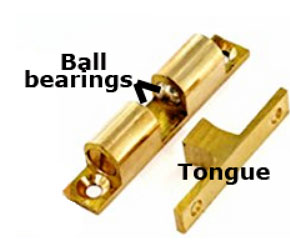
Toggle Cabinet Catches
Again, more often used in cabinet work that kitchen unit work, these toggle latches are great for holding things fast shut and away from prying little fingers.
Unlike most latches, these toggle latches are fitted on the outside of the work and, as can be seen in the image, can also come in a variety which allows you to install a small padlock to really keep the contents safe.
Some toggle catches are spring loaded so when the lever is lifted to release the loop from the hook, the operation is made easier by a spring under the toggle flap. They can be bought in a variety of materials and colours such as Nickel plated, Chrome, Brass, Iron and Silver.
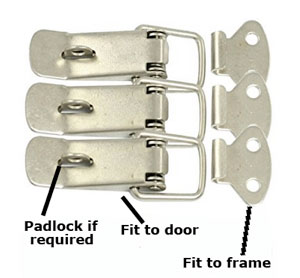
Toggle latches are a more secure latch
Turn button (Granny) Catches
The term Granny catch makes reference to the number of years these simple catches have been around. It is possible to make a Granny or Turn Button catch out of just about anything including bone, china and wood. They are being revived in today’s retro economy and are quite often used with push to open catches and on interior house doors.
One screw holds to button to the door (if the door open inwards) or to the frame if the door opens outwards. Very cheap, very versatile but not at all secure!

Granny or Turn Button Latches can be used on inward or outward opening doors – Available on Amazon here
Fanlight Catches
A fanlight is another name for a skylight and is a high level window, usually over a door or lower window. As the name would imply, these Fanlight Latches were designed to hold the fanlight closed while being very appealing to look at.
As this appeal was/is universal, the versatility of the Fanlight catch has seen them being used for everything from kitchen cupboard doors, to catches used to hold loft-hatches tightly in place. A great little latch with any number of uses.
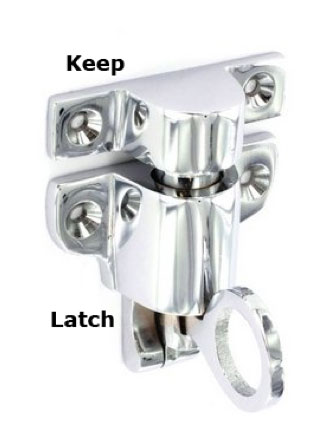
Fanlight catches are often used for cupboard catches – Available from Amazon here
How to Fit a Standard Magnetic Catch to a Cupboard
Fitting a magnetic catch is, on the whole, quite a quick and simple job, requiring only a few tools:
- Magnetic catch kit
- Cordless drill/driver or power drill
- Screwdriver
- 1.5mm drill bit
- Pen/pencil for marking
Position the magnetic catch
The first job is to position the magnetic section of the catch in place. Normally, this will go at the base of the cupboard, in the corner on the opposite side of the hinges. Whether you place it on the base or at the top is entirely up to you.
With the catch in place, ensure it sits about 1mm from the edge of the cupboard and using your pen/pencil, mark the screw holes and then put the catch to one side.
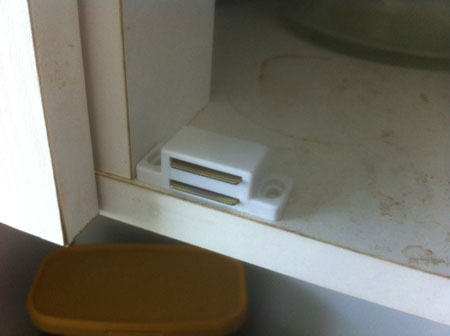
Magnetic catch positioned in place
Drill Pilot Holes
As the screws are very small, you will need a small drilll bit to make your pilot holes. Ideally, this should be ariound the 1.5mm size.
Insert the drill bit in to the drill and drill out your pilot holes, being careful not to drill too deep and go right through the cabinet. About 8-10mm should be more than deep enough.
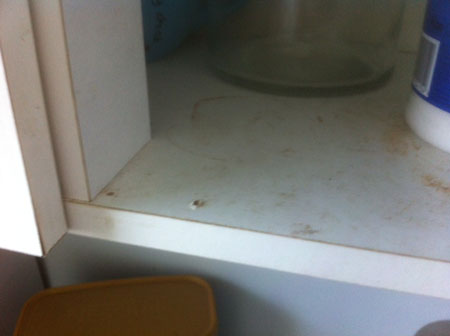
Pilot holes drilled out for magnetic catch
Fix the Catch in Place
Position the catch back in place and take one of the screws and push it through the catch and in to one of your pilot holes.
Use the screwdriver to screw the screw in and down until its tight, but not too tight so that it crushes the plastic screw housing.
As the screws are, in most cases, very small it can be a little tricky to hold them in place and screw them in so take your time as you don’t want the screwdriver to slip and scratch or score the cupboard unit itself.
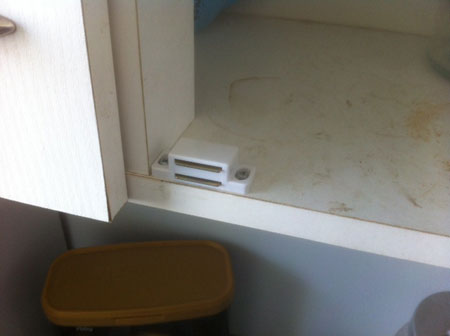
Magnetic catch screwed in to place
Now, repeat the above for the second screw
Position and Fix the Keep Plate
The final part of this job is to fit the keep plate to the door. This can be a bit tricky in terms of making sure that it is in the right position, so that it comes in to contact with the magnetic catch and holds the door closed.
One way of doing this is to push the door closed and use a little force to push it into the magnetic catch, so the catch marks the door. This is a little hit and miss as it’s still quite hard to see where the marks are.
A little trick here is to position the back plate on the catch and then use a black marker pen to colour the back of the plate in. If you then close the door and give it a little push, the pen is then left on the door, marking where the keep needs to go.
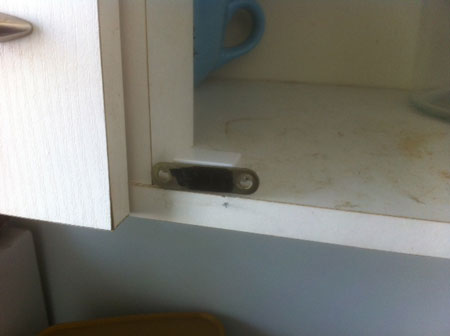
Marker pen added to back of keep to mark position on door
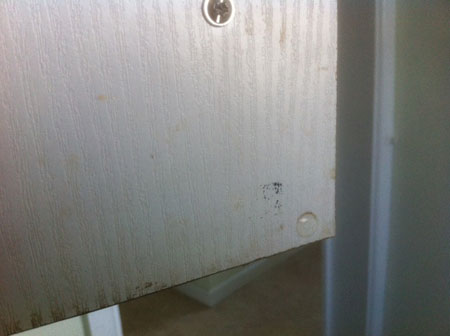
Marker pen left on door to mark position for keep
Position the keep on the door and mark the screw holes. Using your pilot drill, drill out some pilot holes to about 10mm deep (again, be careful not to go all the way through the door).
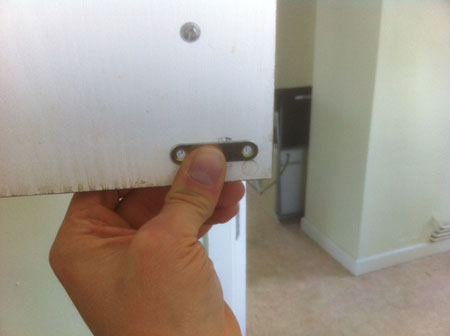
Mark screw holes for keep on cupboard door and drill pilot holes
Put the keep back on the door and screw in one of your screws and then finally the second one.
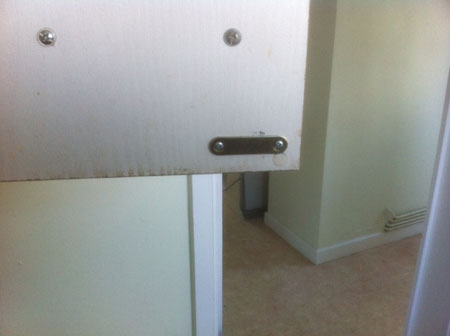
Keep for magnetic catch screwed to door
Close the door to test the catch out and with any luck it should hold the door nicely.
If you find that it’s not holding the door as well and you had hoped you can loosen your screws and move the catch and also the keep plate, there isn’t a huge amount of adjustment available but you should be able to adjust enough to get a decent fit.
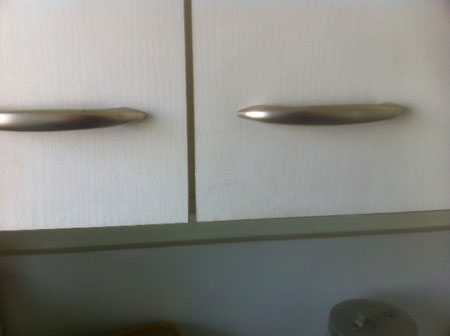
Catch and keep screwed in place on door and cupbord and door closed to test

